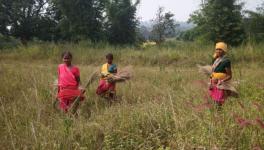Except Odisha, Land Acquisition Still an Issue in Eastern States Despite LARR Act 2013
Representational Image. Image Courtesy: PixaHive.com
Kolkata: The Right to Fair Compensation and Transparency in Land Acquisition, Rehabilitation and Resettlement Act 2013 (LARR) will complete nine years of existence on December 31. Yet, the struggle by social activists for justice for prospective land losers, litigations, police actions, time and cost over-runs and surrender of awarded projects still mark the industry scene in the four eastern states of West Bengal, Odisha, Bihar and Jharkhand.
LARR was fine-tuned by New Delhi in 2015 in the hope that the original Act, read with further relaxations, would help smoothen land acquisition and address the concerns of land losers. Odisha is an exception, but with three other states still to make a mark, the overall show of the region only counts for a little.
This inference is derived from the observations made by industry watchers to NewsClick. All the four states have tried to follow their separate calendars for holding investment summits and have announced the sum of MoUs (memorandum of understanding) signed and investment intentions expressed. They are usually silent on the quantum of encumbrance-free land readily available and the progress of proposals received at earlier such exercises.
But, in this respect, Odisha has attempted a break with the past at the third edition of the ‘Make in Odisha’ conclave, which started in 2016 and is a biennial event. This time round, the conclave was held from November 30 - December 2. Officials claimed the state has 1.59 lakh acres of ready land, implementation of proposals received earlier is about 62%, and incentive disbursal commitments are being honoured. As the state is mineral-rich and has excellent port and road connectivity, sizeable proposals are for the manufacture of metals - ferrous and non-ferrous – and augmentation of Dharma port infrastructure. Projects, among others, have also been proposed for cement, hydel facility and crude-to-petrochemical complex. The value of proposals received was Rs 1.51 lakh crore in 2016 and Rs 4.19 lakh crore in 2018- this time, estimates place it at Rs 9-10 lakh crore.
One of the committed large projects is being promoted by JSW of the Sajjan Jindal Group, whose venture was first committed by Posco of South Korea, which opted out after over a decade’s wait for resolution of the intense agitation against land acquisition.
Early this year, the site at Jagatsinghpur district witnessed a resumed agitation in which social activists took part. The state government has been deploying police to thwart protests and prevent protesters from visiting Dhinkia village, a core part of the site. Veteran anti-displacement agitation organiser and a member of All India Kisan Sabha, Prashant Paikroy, told NewsClick: “Despite our opposition, the Centre apparently with the aim of backing the state government, has given all green clearances and those needed under the Forest Rights Act 2006. Finally, Pratirodh Sangram Samity members have moved the National Green Tribunal.”
Read Also: Odisha Villagers Continue to Protest Jindal Steel Plant Despite Police ‘Brutality’
While political stability and quiet leadership of chief minister Naveen Patnaik are plus points for Odisha, the state too has to contend with land issues that crop up from to time, often for small stretches, when judged by the total area of a project. Therefore, projects need more time and cost overruns. One common contentious issue is the Right of Way for pipeline ventures. Refusal to meet the demand for total compensation payment in one go is also a cause that drives land losers to take recourse to protests.
Bishnu Mohanty, CITU (Centre of Indian Trade Unions) state secretary, said Odisha has a high concentration of tribals, and forest land is a sensitive issue. Acquisition, therefore, is bound to generate discontent; but the situation is not out of control.
Ramkrushna Panda, National secretary of CPI (Communist Party of India), believes there is too much hype, as the unemployment situation does not bear out official claims.
In West Bengal, when the LARR Act 2013 took effect on January 1, 2014, Mamata Banerjee, then in the third year of her first term as chief minister, was busy practising “vendetta” politics against the Left and never bothered about utilising the Act for promoting industries by safeguarding land-givers’ interest.
It was only by the middle of her second term that she started talking about industrialisation, perhaps more as a reaction to persistent Opposition charge that after the Tatas were forced to abandon in 2008, the 85% complete Nano car project at Singur, entrepreneurs were treating West Bengal as untouchable and as a result, there was no job creation.
However, the situation has improved in the past two years, and investors are keeping the state in view. Ventures requiring small parcels of land are materialising. The IT sector now has a strong presence. Days of private sector putting up large, capital-intensive, job-generating projects ended when Sajan Jindal-led JSW Group, responding to the Left Front chief minister Buddhadeb Bhattacharya’s request to set up an integrated steel plant (ISP) at Salboni in Paschim Mednipore district, had to give up as the Biju Janata Dal-led Odisha government refused to give linkage for iron ore.
Instead of an ISP, the state had to be content with cement and paint facilities of the same group. Also, a less known fact is that because of an inordinate delay on the part of Nabanna (state secretariat) to arrange about 4,100 acres at Dubrajpur in Birbhum district for the proposed Khagra-Joydev coal block project, allottee Damodar Valley Corporation (DVC), co-owned by the Centre and West Bengal and Jharkhand governments, surrendered the block to the Union coal ministry in August.
Three thousand five hundred acres were to be procured directly from villagers, and DVC had finally raised the compensation to Rs 35 lakh/acre. It is the same Birbhum district where the Deocha-Pachami coal mining project is located.
Read Also: Mamata does ‘Volte-face’ on Land Acquisition for Coal Mining Project
At the moment, there are two exceptions – ONGC’s oil and gas venture at Ashok Nagar in North 24 Parganas and the Tajpur port project in South 24 Parganas assigned by the state government to the Adani Group, both of which will hopefully be big-ticket investments; thanks to the availability of land and a desperate state government going all-out to help matters.
Industry sources NewsClick contacted for their views on options for West Bengal mentioned the huge tracts of land, which still legally belong to several closed Union government-owned PSUs, lying idle for years. The state government has to take up the matter with the Centre to transfer control of the land to it.
As for land lying with a large number of non-functional private sector plants, the state can act on its own. Recently, the state has identified this avenue and is reportedly considering how it can take over the land with Hindustan Motors, which has been out of production since 2014. Thus, the state can use the LARR Act 2013 in the interest of land-givers.
Mineral-rich Jharkhand, whose resources include uranium, held an investor meeting in August 2021 when it received Rs 10,000 crore worth of proposals. Chief minister Hemant Soren told the gathering that the state wants to look beyond minerals and has kept renewable energy, food processing, pharma, automobile and textiles in view. But land acquisition is a difficult proposition in Jharkhand, given the concentration of adivasis, janjatis and vast tracts of forest land. The case of a power project in Godda district reached the Jharkhand High Court.
Social activist Medha Patkar has ascribed the sufferings of land losers to the states’ amendments to LARR Act to dilute some of the Central Act’s provisions. This is possible because, in the Constitution, land is a subject of the Concurrent List, giving powers both to the Centre and states to frame laws. Moreover, states ignore the provision to hold gram sabhas to interact with villagers and other interested parties and convince them how they will benefit if they part with their land. In the diluted format, it becomes easy for them to acquire land forcibly. In the words of Patkar, states’ amendments “emasculate” the spirit and legislative intent of the 2013 Act to give land givers a decisive say in acquisition and compensation.
Bihar has had two investors’ conferences this year; first in New Delhi in May and the second (after the formation of the mahagathbandhan ministry) in September at the chief minister’s secretariat. Much is not known about the investment intentions expressed, but participants showed interest in food processing mobile manufacture, FMCG (fast-moving consumer goods) and tourism/hospitality segments. In Bihar, land problems often assume serious proportions, and the state’s intervention is often half-hearted, bordering on inaction.
For a 2.8 km-long line strip to connect Patna-Gaya-Dobhi Road, the dispute between National Highways Authority of India (NHAI) and Bihar government that cropped up in 2012-13 persisted for five-six years, with the cost soaring to Rs 580 crore from Rs 176 crore. The Bihar government failed to provide land; instead raised the ‘circle rate’, after which farmers demanded compensation at the new ‘circle rate’. The matter reached the Patna High Court, where a division bench asked the chief secretary to see if the state government and NHAI could share the cost escalation.
For the record: Jharkhand’s industrial and investment promotion policy 2021 provides for incentivising, over and above what is already available, entrepreneurs who commit to engaging 35% of their workforce from the SC and ST communities.
The writer is a freelance journalist based in Kolkata.
Get the latest reports & analysis with people's perspective on Protests, movements & deep analytical videos, discussions of the current affairs in your Telegram app. Subscribe to NewsClick's Telegram channel & get Real-Time updates on stories, as they get published on our website.























